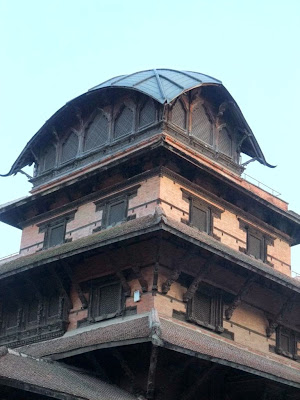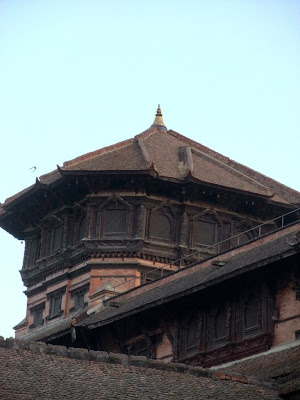
Hanuman Dhoka Durbar Square is another living open museum of Nepal situated at the heart of Kathmandu City. The place was the site where Kings of Nepal were crowned and their coronations solemnized. The 12th to 18th century built temples were all in pagoda style embellished with intricately carved exteriors. The ancient temples and palaces are the epitome of the religious and cultural life of the people.



The site is actually made up of two sub-areas, inner and outer complex. Many renowned shrines are found around outer complex and Jagannath Temple which is famous for erotic carvings on its roof struts, is the oldest structure in the square. It is a two storey building resting on a 3-tiered platform, enshrined with an image of Jagannath dated back to year 1563. In front of Jagannath Temple stands the Column of King Pratap Malla.



Making offerings to destructive manifestation of deity Shiva named as Bhairav. The huge stone image of Bhairav was found in a field north of Kathmandu and placed in the present spot by King Pratap Malla. The site of Kal Bhairav now is a place for people to swear the truth.


Taleju Temple is one of the notable temples in the inner complex. It was built in 1564 by King Mahendra Malla to dedicate to the royal deity Goddess Taleju. The temple seated on a 12 stage plinth is 36.6 meters in height. There are 12 miniature temples at the broaden step of the 8th plinth. The three roofs of Taleju Temple soar above all complexes in Hanuman-dhoka Square. People still believed till today, that it was inauspicious to build structures higher than this temple.



The octagonal building around the corner was Chyasin Dega which was also known as Vansagopal Temple literally means Krishna playing the flute. It was built in year 1649 by King Pratap Malla in memory of his two demised queens. The present structure was renovated in year 1967



The 3-tiered building structure built in year 1757 by King Jaya Prakash Malla was known as Kumari-ghar. It is the home of a living goddess called Kumari who was believed to be an incarnation of the Goddess Taleju. The building was lavishly decorated with fine woodcarvings.


Kumari has many admirers and the attractive bay windows at the 3rd floor is where she appears from time to time, accompanied by her guardian.



Basantapur Durbar commonly called as Kathmandu Tower was also known as Nau-talle Durbar. The dominant nine storey structure that built along with 3 other towers, was established in year 1770 by King Prithvi Narayan. The original palace complex was said to be first established during Lichchhavi Kingdom period in 4th century but the existing structure was restored in 17th century by King Pratap Malla and followed with many renovations after that. The present architectural remains and artifacts within the complex were mostly from Kingdom Malla, Shah and Rana.



The eastern side of the Palace was closed off by this European styled white building which was built in year 1908 by Chandra Shamsher during Shah era, as a part of the palace. Hanuman-dhoka Square was the Kings residence until early 20th century.



Attached closely next to the white palace building was Bhagwati Temple.


Kirtipur Tower, Bhaktapur Tower and Lalitpur tower are the three towers that were named after the three ancient cities of Kathmandu Valley. They represent the three Kingdoms of Nepal (Bhaktapur, Patan and Kathmandu).


The three towers from the three different period of Kingdoms beautifully reflect the different architectural arts and styles of the period. Gorgeous!



Nasal Chowk is the courtyard inside Hanuman Dhoka palace which has now been converted to museum and arts gallery. The small stone platform in Nasal Chowk was the coronation stage in the past. By the side of the golden gate into Nasal Chowk, there is an open stone alter enshrined with a kneeling image of Hindu God Hanuman, who was always depicted in the form of monkey. It was offered by King Pratap Malla in 1672 (photographing prohibited).


The wood carved windows and doors of Hanuman Dhoka Palace are pieces of arts.


The square shaped Trilokya Mohan Narayan Temple standing on a 5-stage plinth with 3 tiers of roofs was built in year 1690 by Queen's mother Riddhi Laxmi. It was dedicated to Hindu God Vishnu. The roof struts were carved with different images and there is a huge kneeling image of Garud at the west corner. It is a venue of Indrajatra festival where people flock in to watch the 10 incarnations of Vishnu. The round shaped pagoda-styled structure, if I was not mistaken, should be Temple Pancha Mukhi Hanuman.



Further up from Temple Trilokya Mohan Narayan is another similar style pagoda temple
Maju Dega



Temple Maju Dega constructed in late 17th century is the most impressive tiered structure at the square. The shrine stands on a platform that was built up with 9 layers of brick steps. There are images of Hindu deities inside and outside the shrine. Wooden doorway, pillars, windows and struts were all beautifully carved.



Shiva-Parbati Temple is a little shrine built on a 3 steps brick platform. The two figures that were looking down from the central window at first floor were dated back to the period of King Rana Bahadur Shah. They were addressed as Mahadev and Parvati.

The three storey public building of Kasthamandap with an impressive open underground basement, was believed to be built from a single tree in 12th century. It enshrines an image of Gorakhnath at the center and images of Ganesh at four corners. The Temple, known as Maru Sattal locally, had gone through many renovations since it was constructed.


There is no place in the world to have such an active corner by the side of an ancient Palace site. The interesting religious and cultural spot not only offer a venue for devotees to praying and making offerings, establish a stage for youngsters to meet and gather, but also spare out a little corner for people to earn their livings. We were impressed with such harmonious encounter.



The while stretch of old building at the end of the Square, though is not as attractive as the The Arts Street, it was once the Hippies joints for the westerners in mid 20th century.


No comments:
Post a Comment